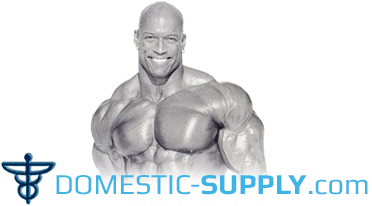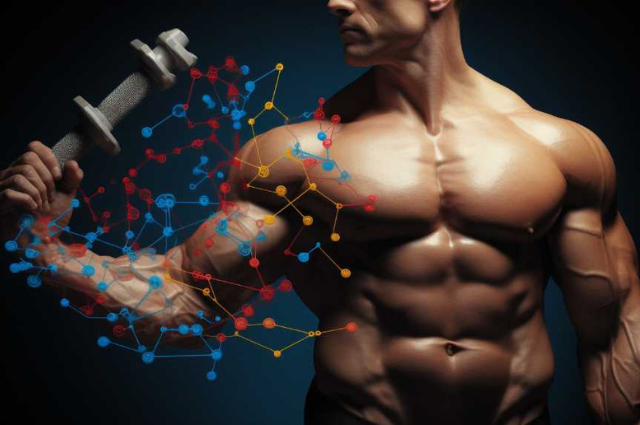What Role Do Anabolic Steroids Play in Muscle Growth?
Anabolic steroids are synthetic substances similar to the male hormone testosterone. They are utilized in the realm of fitness and bodybuilding for their ability to stimulate muscle growth and enhance physical performance. The role of these substances in muscle growth is complex, involving both physiological and biochemical processes.
Anabolic steroids increase protein synthesis within cells, leading to an increased buildup of cellular tissue, particularly in muscles. However, it's crucial to understand that the misuse of these substances can lead to significant health complications.
This article aims to delve into the role of anabolic steroids in muscle growth, highlighting both their potential benefits and risks.
Key Takeaways
- Anabolic steroids stimulate muscle growth and enhance physical performance.
- They increase protein synthesis within cells and promote the buildup of cellular tissue, particularly in muscles.
- Anabolic steroids bind to androgen receptors in various cells, stimulating protein synthesis and reducing protein breakdown.
- Long-term use of anabolic steroids can lead to hormonal imbalances and significant health complications.
Understanding Anabolic Steroids
Commonly, anabolic steroids are synthetic substances that mimic the muscle-building characteristics of the male hormone testosterone. These compounds are derived from molecules of testosterone, modified to enhance their anabolic, or tissue-building properties, while minimizing their androgenic, or masculinizing characteristics. The central aim is to augment muscle mass, and this is achieved by promoting the synthesis of proteins in cells, leading to an increased buildup of cellular tissue, particularly in muscles.
Scientifically, anabolic steroids function by binding to the androgen receptor located in various cells within the body. Once bound, the steroid-receptor complex moves into the cell nucleus, where it acts on the cell's DNA and stimulates the protein synthesis process. This results in cell growth, particularly in muscle cells.
The impact of anabolic steroids on muscle growth is significant, as they accelerate the rate of protein synthesis, reduce protein breakdown, and promote the differentiation of certain types of cells into muscle cells. However, this process is not without risks. The misuse of these substances can lead to a range of health issues, including hormonal imbalances, liver damage, and cardiovascular diseases.
The Science Behind Steroids
Delving deeper into the science behind steroids elucidates the intricate biochemical processes that facilitate muscle growth. At the core of this process is the interaction between anabolic steroids and muscle cells. Steroids, synthetic versions of the male sex hormone testosterone, bind to androgen receptors on muscle cells. This binding triggers a cascade of biochemical reactions leading to increased protein synthesis, the process by which cells construct new proteins and thus, muscle tissue.
The process is further augmented by the steroids' ability to reduce the impact of catabolic hormones. These hormones, such as cortisol, are responsible for breaking down muscle tissue, a process known as muscle catabolism. By inhibiting these catabolic hormones, anabolic steroids essentially shift the body's balance towards muscle anabolism, the building up of muscle tissue.
Moreover, steroids also promote cell volumization, a process by which muscle cells retain more water, thereby increasing their size. This, in combination with increased protein synthesis, results in substantial muscle growth.
Critical to understanding the science behind steroids is the concept of the anabolic-androgenic ratio. Steroids are developed and used based on their anabolic (muscle-building) properties relative to their androgenic (masculinizing) properties. The goal is to maximize muscle growth while minimizing side effects related to the androgenic properties, such as acne and body hair growth.
However, the muscle-building effects of anabolic steroids don't come without risks. Chronic usage can lead to a number of health issues, including liver damage, cardiovascular problems, and psychological effects. Thus, while steroids can significantly enhance muscle growth, their potential risks cannot be overlooked.
Anabolic Steroids and Muscle Growth
The role of anabolic steroids in facilitating muscle growth is a multifaceted process, deeply rooted in the body's biochemistry and physiology. These compounds, which are synthetic derivatives of testosterone, bind to androgen receptors in skeletal muscle cells, triggering a cascade of biochemical reactions that promote protein synthesis and cell growth.
The primary mechanism involves the recruitment of transcription factors to specific regions of the DNA in muscle cells. These factors 'switch on' genes that code for muscle proteins, thereby increasing the rate of protein synthesis. This augmented protein production, coupled with the suppression of protein degradation, leads to an overall increase in muscle mass.
Alongside this, anabolic steroids also induce the release of insulin-like growth factor (IGF-1), a potent mediator of muscle growth. IGF-1 promotes the differentiation and proliferation of satellite cells, which are essentially muscle stem cells. These cells fuse with existing muscle fibers, contributing to their growth and repair.
Furthermore, anabolic steroids have been found to enhance the production of erythropoietin, a hormone that stimulates red blood cell production. This results in increased oxygen-carrying capacity of the blood, thereby enhancing endurance and recovery.
However, it is critical to note that these physiological changes come with significant risks. Long-term use of anabolic steroids can lead to hormonal imbalances, cardiovascular diseases, liver damage, and psychological disorders. Therefore, while they can potentiate muscle growth, the potential health risks associated with their use cannot be trivialized.
Side Effects of Steroid Use
Over time, the use of anabolic steroids can result in numerous adverse side effects that pose significant risks to an individual's health. While the immediate appeal of increased muscle mass and enhanced athletic performance can be tempting, these transient benefits are often overshadowed by a plethora of health complications.
Systemically, anabolic steroids precipitate a myriad of negative effects, affecting both the cardiovascular and endocrine systems. Cardiovascular risks include left ventricular hypertrophy, hypertension, thrombosis, and dyslipidemia, all of which contribute to an increased incidence of myocardial infarction and stroke. Concerning the endocrine system, steroid use disrupts the hypothalamic-pituitary-gonadal axis, leading to decreased endogenous testosterone production, testicular atrophy, and infertility.
Furthermore, steroids exert deleterious effects on the liver, often leading to a spectrum of hepatotoxicity ranging from mild elevations in liver enzymes to life-threatening hepatic failure. Psychiatric disturbances such as mood swings, aggression, depression, and even psychosis have also been associated with steroid use.
On a dermatological level, steroid use can lead to acne, thinning of the skin, and poor wound healing. In females specifically, virilizing effects such as hirsutism, deepening of the voice, and menstrual irregularities can occur.
In conclusion, the use of anabolic steroids comes with an alarming array of side effects that can significantly compromise an individual's health. As such, the short-term allure of rapid muscle growth should be carefully weighed against the long-term potential for serious health complications.
Public education and awareness of these risks are crucial to dissuade misuse and promote healthier alternatives for muscle growth.
Legal Consequences of Steroid Abuse
In addition to the serious health risks, abuse of anabolic steroids also carries potential legal consequences that further compound the issue. The illicit use, possession, manufacturing, and distribution of anabolic steroids is considered a criminal act in many jurisdictions globally. These substances are classified under controlled substances in several countries, strictly regulated due to their potential abuse and associated health risks.
In the United States, for instance, anabolic steroids fall under Schedule III of the Controlled Substances Act. This classification implies that these substances have a recognized medical use but also a high potential for abuse, leading potentially to severe psychological or physical dependence. Therefore, individuals found guilty of unauthorized possession, distribution, or use of these substances can face significant penalties, including imprisonment and hefty fines.
Moreover, athletes caught using anabolic steroids for performance enhancement face additional legal consequences. They could be banned from participating in sports, stripped of their titles, and even face lawsuits. For example, the International Olympic Committee and the National Collegiate Athletic Association (NCAA) have stringent anti-doping regulations that include severe penalties for steroid abuse.
The legal consequences of anabolic steroid abuse serve to underline the seriousness of this issue. It is not only a matter of personal health, but also of legal integrity and fair competition in sports. Strict enforcement of these laws and regulations is crucial to deter potential abusers and to maintain the integrity of athletic competition.
Therefore, the legal implications of anabolic steroid use are a significant factor in the broader discussion about their role in muscle growth and performance enhancement.
Anabolic Steroids in Professional Sports
Frequently, the discussion around anabolic steroids extends into the realm of professional sports, where they have been notably used for boosting athleticism and performance. The allure of these substances is primarily their capacity to stimulate muscle growth and recovery, enhancing an athlete's strength and endurance. They achieve this by imitating the action of the male hormone testosterone, promoting protein synthesis in cells, resulting in the buildup of cellular tissue, particularly in muscles.
However, the use of anabolic steroids in professional sports is a contentious issue. Many sports governing bodies, including the International Olympic Committee (IOC) and various professional sports leagues, have banned their use due to health risks and to maintain fair competition. Despite these prohibitions, the incidence of steroid use remains an enduring issue. This is evidenced by high profile doping scandals that have rocked sports like cycling, athletics, and baseball.
Scientific studies have corroborated the concerns around steroid use. Prolonged use can lead to cardiovascular diseases, liver damage, psychiatric disorders, and endocrine abnormalities. Furthermore, the artificial enhancement of performance undermines the spirit of fair competition, which is a fundamental aspect of professional sports.
Strategies to curb steroid use in professional sports have been largely focused on stringent testing and severe penalties for violations. However, these efforts need to be supplemented with educational programs to highlight the health risks and ethical implications of steroid use. It is imperative for the integrity of professional sports that the use of anabolic steroids and other performance-enhancing drugs is effectively tackled.
Alternatives to Anabolic Steroids
While a significant number of athletes may resort to anabolic steroids for muscle growth and performance enhancement, there are safer alternatives available that do not pose the same health risks or ethical dilemmas. These alternatives, often referred to as natural steroids, include supplements and lifestyle modifications that promote muscle growth and strength naturally, without the adverse effects associated with anabolic steroids.
Protein supplements, for instance, are a popular choice among athletes. They provide the body with essential amino acids needed for muscle repair and growth. Consuming protein supplements post-workout can significantly increase muscle protein synthesis and promote muscle growth. Additionally, branched-chain amino acids (BCAAs), particularly leucine, isoleucine, and valine, have been proven to stimulate protein synthesis, hence facilitating muscle growth.
Creatine, another widely used supplement, has been scientifically proven to improve strength and muscle mass. It works by increasing phosphocreatine in muscles, which in turn produces more ATP, a critical energy source for muscle contractions during workouts.
In addition to these supplements, a balanced diet is crucial. It should be rich in proteins, healthy fats, and carbohydrates to provide the necessary nutrients for muscle growth. Regular exercise, particularly strength training, is also essential as it stimulates the growth of muscle fibers.
Another alternative is Selective Androgen Receptor Modulators (SARMs). SARMs, like anabolic steroids, bind to androgen receptors, but they do so selectively, resulting in fewer side effects. However, their use is controversial and they are currently not approved by the FDA for muscle building.
Responsible Use of Anabolic Steroids
The responsible use of anabolic steroids requires a thorough understanding of their potential effects, risks, and the importance of medical supervision. Steroids are powerful substances that can significantly influence the body's metabolic processes. They can stimulate protein synthesis and muscle growth, but can also lead to harmful side effects if misused or abused.
Anabolic steroids, particularly when taken in doses higher than therapeutic ranges, can cause a range of adverse effects. These may include cardiovascular complications such as hypertension and myocardial infarction, psychiatric disturbances like aggression and mood swings, endocrine disorders, and liver damage. Therefore, any use of these substances should be under the guidance and supervision of a healthcare professional.
Furthermore, responsible use implies adhering to recommended dosages and cycles. Overdosing and prolonged use can exacerbate the risk of side effects and lead to steroid dependency. A cycle refers to the period during which steroids are taken, followed by a period of abstention to allow the body to recover. It is also essential to combine steroid use with a well-balanced diet and regular exercise to optimize results and mitigate potential risks.
Lastly, it is crucial to source steroids from reliable and legal channels to ensure their quality and safety. Counterfeit or substandard products pose significant health risks, including contamination and incorrect dosing.
Frequently Asked Questions
Can Anabolic Steroids Improve Performance in Sports Other Than Bodybuilding?
Anabolic steroids can enhance performance in sports beyond bodybuilding due to their ability to promote muscle growth and recovery. They can increase the body's protein synthesis, leading to improved strength and endurance.
However, their use is often associated with significant health risks and ethical considerations. Therefore, while they may provide short-term performance benefits in various sports, it is crucial to consider the potential long-term implications.
What Are the Psychological Effects of Anabolic Steroid Use?
Anabolic steroid use can have significant psychological effects. These may include:
- Mood swings
- Increased aggression
- Anxiety
- Depression
- Paranoia
Some users may also experience manic symptoms leading to violent behavior, known as 'roid rage'.
Furthermore, steroids may cause physical dependence and withdrawal symptoms upon cessation.
Prolonged use can also lead to cognitive impairment, affecting attention, memory, and visuospatial abilities.
It's essential to consider these risks when evaluating anabolic steroid use.
How Prevalent Is Anabolic Steroid Use Among Teenagers and What Are the Risks?
Anabolic steroid use among teenagers is a growing concern. The prevalence is difficult to quantify due to secretive usage patterns, but studies indicate a significant minority engage in this behavior.
Risks include stunted growth, liver damage, cardiovascular issues, and psychological effects like aggression and mood disorders. Furthermore, the use of non-prescribed steroids raises the risk of infection from shared needles or contaminated substances.
Prevention efforts must address these serious health risks.
Can Anabolic Steroids Be Used for Medical Purposes or Treatments?
Yes, anabolic steroids can be used for medical purposes. They are often prescribed to treat conditions that cause muscle loss, such as cancer or AIDS. Their muscle-building properties have also been used to treat chronic wasting conditions.
However, their use must be carefully monitored due to potential side effects, including liver damage, cardiovascular issues, and behavioral changes. Therefore, their application in medicine is limited and strictly regulated.
How Does Long-Term Anabolic Steroid Use Affect Overall Life Expectancy?
Long-term anabolic steroid use can significantly impact life expectancy due to associated health risks. These include cardiovascular diseases, liver damage, and mental health disorders such as depression and aggression.

Steroid misuse can also lead to hormonal imbalances, causing secondary sexual characteristic changes and infertility.
Therefore, while steroids might offer temporary physical enhancements, their long-term use poses serious threats to overall health and longevity.
Conclusion
In conclusion, anabolic steroids significantly stimulate muscle growth by increasing protein synthesis and cell reproduction.
However, their consumption is not devoid of side effects, which can be severe and life-threatening.
Despite their illegal status in professional sports and potential legal consequences, their use persists.
Alternatives to anabolic steroids exist, emphasizing the importance of natural and healthier methods to gain muscle mass.
Responsible use under medical supervision is crucial to mitigate adverse effects.





